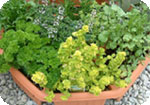| Monday, 12 May 2025 Home • About Us • Contact Us |
|
|
|
You are here:
Herbs are some of the easiest plants to grow and can be grown in the smallest of spaces. Fresh-picked herbs always taste better than store-bought herbs and it is great to have fresh herbs at hand to use in dishes all year round.
Herbs can be grown outside in the garden, in containers, in hanging baskets or indoors on a sunny windowsill. It is a good idea to situate the herbs close to the kitchen for easy access, but any spot that gets sunlight is suitable. To save time, ready-grown herb plants can be bought from a garden centre or specialist supplier. What to Grow Herbs commonly grow in two different ways: annual and perennial. Annual plants last one growing season and die when the temperature hits freezing. Examples include basil, dill, coriander and parsley. Perennial plants, on the other hand produce new stems year after year. Examples include thyme, mint, chives, sage and tarragon. It is a good idea to clump herbs that grow in a similar way together. This will make it easier when replanting new herbs.
Keep the herbs in warm sunlight and water regularly. To ensure you have lots of new leaves, pick regularly from the tips of plants, which stimulates new growth. As herbs are cut-and-come-again plants, with frequent picking most herbs can be harvested for several months. Begin harvesting from the herbs as soon as they are mature, but take only a little bit each time you harvest. If you remove more than a third of the plant at one time, it will take longer to recover and produce new foliage. By late autumn, annual herbs such as basil and coriander will begin to die and can be discarded. Perennial herbs such as mint, thyme or chives will die back, but will re-grow in the spring. Pots or containers should be protected during frost and ideally brought indoors.
Link to this article: Show: HTML Link • Full Link • Short Link
Related Articles:
You must be registered and logged in to comment. |
|
 |
 | |
|
|








